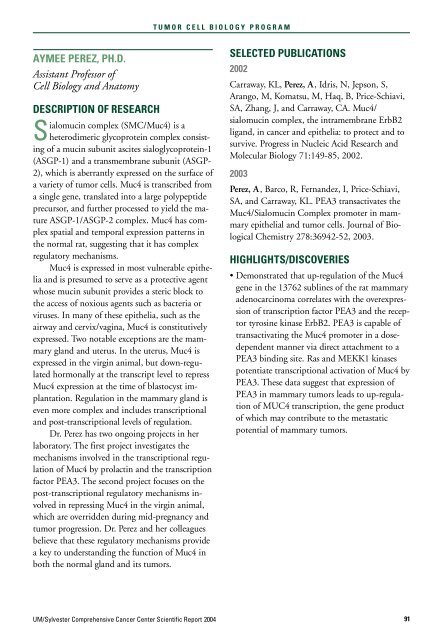SCIENTIFIC REPORT 2004 - Sylvester Comprehensive Cancer Center
SCIENTIFIC REPORT 2004 - Sylvester Comprehensive Cancer Center
SCIENTIFIC REPORT 2004 - Sylvester Comprehensive Cancer Center
You also want an ePaper? Increase the reach of your titles
YUMPU automatically turns print PDFs into web optimized ePapers that Google loves.
T U M O R C E L L B I O L O G Y P R O G R A M<br />
AYMEE PEREZ, PH.D.<br />
Assistant Professor of<br />
Cell Biology and Anatomy<br />
DESCRIPTION OF RESEARCH<br />
Sialomucin complex (SMC/Muc4) is a<br />
heterodimeric glycoprotein complex consisting<br />
of a mucin subunit ascites sialoglycoprotein-1<br />
(ASGP-1) and a transmembrane subunit (ASGP-<br />
2), which is aberrantly expressed on the surface of<br />
a variety of tumor cells. Muc4 is transcribed from<br />
a single gene, translated into a large polypeptide<br />
precursor, and further processed to yield the mature<br />
ASGP-1/ASGP-2 complex. Muc4 has complex<br />
spatial and temporal expression patterns in<br />
the normal rat, suggesting that it has complex<br />
regulatory mechanisms.<br />
Muc4 is expressed in most vulnerable epithelia<br />
and is presumed to serve as a protective agent<br />
whose mucin subunit provides a steric block to<br />
the access of noxious agents such as bacteria or<br />
viruses. In many of these epithelia, such as the<br />
airway and cervix/vagina, Muc4 is constitutively<br />
expressed. Two notable exceptions are the mammary<br />
gland and uterus. In the uterus, Muc4 is<br />
expressed in the virgin animal, but down-regulated<br />
hormonally at the transcript level to repress<br />
Muc4 expression at the time of blastocyst implantation.<br />
Regulation in the mammary gland is<br />
even more complex and includes transcriptional<br />
and post-transcriptional levels of regulation.<br />
Dr. Perez has two ongoing projects in her<br />
laboratory. The first project investigates the<br />
mechanisms involved in the transcriptional regulation<br />
of Muc4 by prolactin and the transcription<br />
factor PEA3. The second project focuses on the<br />
post-transcriptional regulatory mechanisms involved<br />
in repressing Muc4 in the virgin animal,<br />
which are overridden during mid-pregnancy and<br />
tumor progression. Dr. Perez and her colleagues<br />
believe that these regulatory mechanisms provide<br />
a key to understanding the function of Muc4 in<br />
both the normal gland and its tumors.<br />
SELECTED PUBLICATIONS<br />
2002<br />
Carraway, KL, Perez, A, Idris, N, Jepson, S,<br />
Arango, M, Komatsu, M, Haq, B, Price-Schiavi,<br />
SA, Zhang, J, and Carraway, CA. Muc4/<br />
sialomucin complex, the intramembrane ErbB2<br />
ligand, in cancer and epithelia: to protect and to<br />
survive. Progress in Nucleic Acid Research and<br />
Molecular Biology 71:149-85, 2002.<br />
2003<br />
Perez, A, Barco, R, Fernandez, I, Price-Schiavi,<br />
SA, and Carraway, KL. PEA3 transactivates the<br />
Muc4/Sialomucin Complex promoter in mammary<br />
epithelial and tumor cells. Journal of Biological<br />
Chemistry 278:36942-52, 2003.<br />
HIGHLIGHTS/DISCOVERIES<br />
• Demonstrated that up-regulation of the Muc4<br />
gene in the 13762 sublines of the rat mammary<br />
adenocarcinoma correlates with the overexpression<br />
of transcription factor PEA3 and the receptor<br />
tyrosine kinase ErbB2. PEA3 is capable of<br />
transactivating the Muc4 promoter in a dosedependent<br />
manner via direct attachment to a<br />
PEA3 binding site. Ras and MEKK1 kinases<br />
potentiate transcriptional activation of Muc4 by<br />
PEA3. These data suggest that expression of<br />
PEA3 in mammary tumors leads to up-regulation<br />
of MUC4 transcription, the gene product<br />
of which may contribute to the metastatic<br />
potential of mammary tumors.<br />
UM/<strong>Sylvester</strong> <strong>Comprehensive</strong> <strong>Cancer</strong> <strong>Center</strong> Scientific Report <strong>2004</strong> 91
















